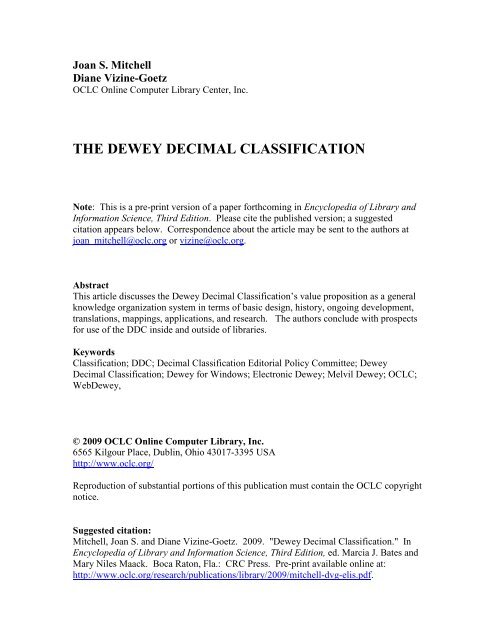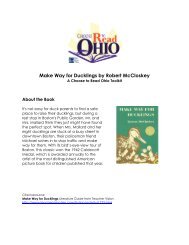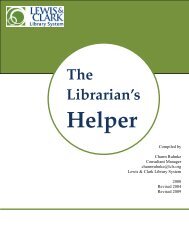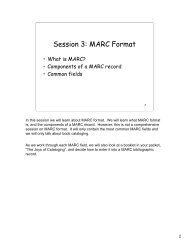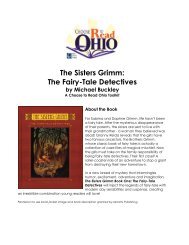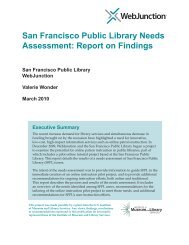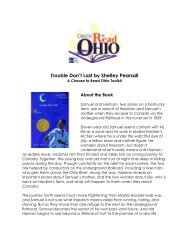THE DEWEY DECIMAL CLASSIFICATION - OCLC
THE DEWEY DECIMAL CLASSIFICATION - OCLC
THE DEWEY DECIMAL CLASSIFICATION - OCLC
- No tags were found...
Create successful ePaper yourself
Turn your PDF publications into a flip-book with our unique Google optimized e-Paper software.
Joan S. MitchellDiane Vizine-Goetz<strong>OCLC</strong> Online Computer Library Center, Inc.<strong>THE</strong> <strong>DEWEY</strong> <strong>DECIMAL</strong> <strong>CLASSIFICATION</strong>Note: This is a pre-print version of a paper forthcoming in Encyclopedia of Library andInformation Science, Third Edition. Please cite the published version; a suggestedcitation appears below. Correspondence about the article may be sent to the authors atjoan_mitchell@oclc.org or vizine@oclc.org.AbstractThis article discusses the Dewey Decimal Classification’s value proposition as a generalknowledge organization system in terms of basic design, history, ongoing development,translations, mappings, applications, and research. The authors conclude with prospectsfor use of the DDC inside and outside of libraries.KeywordsClassification; DDC; Decimal Classification Editorial Policy Committee; DeweyDecimal Classification; Dewey for Windows; Electronic Dewey; Melvil Dewey; <strong>OCLC</strong>;WebDewey,© 2009 <strong>OCLC</strong> Online Computer Library, Inc.6565 Kilgour Place, Dublin, Ohio 43017-3395 USAhttp://www.oclc.org/Reproduction of substantial portions of this publication must contain the <strong>OCLC</strong> copyrightnotice.Suggested citation:Mitchell, Joan S. and Diane Vizine-Goetz. 2009. "Dewey Decimal Classification." InEncyclopedia of Library and Information Science, Third Edition, ed. Marcia J. Bates andMary Niles Maack. Boca Raton, Fla.: CRC Press. Pre-print available online at:http://www.oclc.org/research/publications/library/2009/mitchell-dvg-elis.pdf.
Mitchell and Vizine-Goetz: The Dewey Decimal ClassificationINTRODUCTIONThe Dewey Decimal Classification (DDC) 1 system is a general knowledge organizationsystem that is continuously revised to keep pace with knowledge. The DDC is usedaround the world in 138 countries; over sixty of these countries also use Dewey toorganize their national bibliographies. Over the lifetime of the system, the DDC has beentranslated into more than thirty languages.The system has value because of its well-defined categories, well-developed hierarchies,rich network of relationships among topics, worldwide use, and language-independentrepresentation of concepts. The existence of interoperable translations, mappings to othersubject schemes, and the large amount of categorized content already associated with thesystem also contribute to Dewey’s value proposition.BASIC DESIGNSTRUCTURE AND NOTATIONThe DDC structures knowledge by disciplines or fields of study in a general-to-specificarrangement in well-developed hierarchies. At the top level, the DDC includes ten mainclasses:000 Computer science, information & general works100 Philosophy & psychologyhttp://www.oclc.org/research/publications/library/2009/mitchell-dvg-elis.pdf Page 2 of 36.
Mitchell and Vizine-Goetz: The Dewey Decimal Classification200 Religion300 Social sciences400 Language500 Science600 Technology700 Arts & recreation800 Literature900 History & geographyEach main class is divided into ten divisions, and each division is divided into tensections (some numbers in the divisions and sections have not been used—these aremarked as “Unassigned”):500 Science510 Mathematics510 Mathematics511 General principles of mathematics512 Algebra513 Arithmetic514 Topology515 Analysis516 Geometryhttp://www.oclc.org/research/publications/library/2009/mitchell-dvg-elis.pdf Page 3 of 36.
Mitchell and Vizine-Goetz: The Dewey Decimal Classificationsystems, and 006.8 Virtual reality. All but the last are further subdivided. In addition,each of these classes (including the last) can be further extended by general notationalsynthesis rules as well as instructions in specific classes.Classes 000-999 are known collectively as “the schedules”; there are also six auxiliarytables (Tables 1-6) that support notational synthesis:Table 1. Standard SubdivisionsTable 2. Geographic Areas, Historical Periods, PersonsTable 3. Subdivisions for the Arts, for Individual Literatures, for SpecificLiterary FormsTable 4. Subdivisions of Individual Languages and Language FamiliesTable 5. Ethnic and National GroupsTable 6. LanguagesNotation in tables is represented in the print edition with an em dash followed by thenumber, e.g., —624 Sudan is the Table 2 number for the country of Sudan. In theRelative Index in the print edition, and throughout the current web version, the samenumber is represented byT2—624. The prefix for the table number and the em dashare removed when the notation is appended to another number (see NOTATIONALSYN<strong>THE</strong>SIS).The schedules and tables also include some numbers enclosed in square brackets andparentheses. Numbers in square brackets are not in current use. Numbers in parenthesesare optional numbers—alternate notation for a concept. Optional numbers are providedto give emphasis to a topic not given preferred treatment in the standard notation 2 . Forhttp://www.oclc.org/research/publications/library/2009/mitchell-dvg-elis.pdf Page 5 of 36.
Mitchell and Vizine-Goetz: The Dewey Decimal Classificationexample, Library and Archives Canada routinely prefaces the notation for Americanliterature in English and French literature with “C” to represent Canadian literature, e.g.,C813.6 is the optional number for 21 st century Canadian fiction in English; 813.6 is thestandard number for the same concept.Accompanying the schedules and tables are the Manual and the Relative Index. TheManual provides extended discussions on choices among related numbers, and onclassification in complicated areas of the tables and schedules. The Manual was firstpublished in 1982 as a supplement to DDC 19 3 ; it was fully integrated into the systemwith the publication of DDC 20 4 .The DDC is indexed by a unique tool known as the “Relative Index.” The index is sonamed because it shows the relationship between subjects and the disciplines (or in somecases, the various aspects within disciplines) in which they appear. For example, theRelative Index entries for Garlic are as follows:Garlic 641.3526Garlic—botany 584.33Garlic—cooking 641.6526Garlic—food 641.3526Garlic—garden crop 635.26Garlic—pharmacology 615.32433Within 641 Food and drink, garlic appears in food (641.3526) and cooking (641.6526).Garlic also appears in botany (584); as a garden crop in agriculture (635.26); and in ahttp://www.oclc.org/research/publications/library/2009/mitchell-dvg-elis.pdf Page 6 of 36.
Mitchell and Vizine-Goetz: The Dewey Decimal Classificationsubfield of medicine, pharmacology (615.32433). The interdisciplinary number for garlicis the one that appears opposite the unsubdivided entry for garlic (641.3526).The Relative Index has been a feature of the DDC since the first edition of the system,and is considered one of Melvil Dewey’s unique contributions. Miksa 5 traces the historyof the Relative Index through the twenty-two full editions of the DDC with specialattention to its nature as a conceptual indexing system, the conceptual contexts providedby Relative Index, and its treatment of concepts resident in internal tables. Green 6investigates the explicit and implicit relationships between Relative Index terms andtopics in the schedules and tables.CLASSES, HIERARCHIES, AND RELATIONSHIPSEach class in the DDC is defined by its position in a hierarchy, notes within the class, anda rich network of relationships with other classes. Relationships may be explicitly statedwithin the class itself, within other classes, and inherited through hierarchicalrelationships.Entries in the schedules and tables have two main components—a DDC number and aheading (caption) describing the number. The entry may also contain notes that furtherdescribe the class, provide instruction for notational synthesis, or define its relationshipswith other classes.796.932 Cross-country skiingIncluding biathlonClass here Nordic combination, Nordic skiingFor jumping, see 796.933http://www.oclc.org/research/publications/library/2009/mitchell-dvg-elis.pdf Page 7 of 36.
Mitchell and Vizine-Goetz: The Dewey Decimal ClassificationHierarchy in the DDC is expressed through structure and notation. The DDC organizesknowledge first by discipline and then by subject in a hierarchical structure in whichtopics progress from the general to the specific. Each of the classes subordinate to the tenmain classes needs to be considered in terms of the hierarchy. Notes with “hierarchicalforce” regarding the nature of a class at any point in the hierarchy also apply tosubordinate classes and to referenced classes.The hierarchy is largely expressed through the notation. For a class within a givenhierarchy, the next broader topic will generally be represented by a number one digitshorter, and subordinate topics will generally be one digit longer. Coordinate topics areusually represented by the same number of digits. For example, here are several specificice and snow sports shown in the context of their complete hierarchy.700 Arts & recreation790 Recreational and performing arts796 Athletic and outdoor sports and games796.9 Ice and snow sports796.91 Ice skating796.92 Snowshoeing796.93 Skiing and snowboardingThe classes 796.91, 796.92, and 796.93 are coordinate classes—they are directlysubordinate to class 796.9 Ice and snow sports, which in turn is subordinate to section796 Athletic and outdoor sports and games. Section 796 is part of division 790Recreational and performing arts, which is part of main class 700 Arts & recreation.http://www.oclc.org/research/publications/library/2009/mitchell-dvg-elis.pdf Page 8 of 36.
Mitchell and Vizine-Goetz: The Dewey Decimal ClassificationGENERAL RULES FOR CLASSIFYING WITH <strong>THE</strong> DDCThe general rules for classifying with Dewey are set forth in the introduction to theDDC 7 . Additional instructions are found in the beginning of Tables 1-6 (in the electronicversion, the instructions can be found in the “0” record associated with each table, e.g.,T1—0), in individual schedule and table records, and in the Manual notes associated withselected entries.Since Dewey was originally developed to order physical materials, the instructions aregeared toward the selection of a single number to represent any document-like object.The rules for choice of a single number also facilitate sharing of Dewey numbers amongusers, e.g., through bibliographic cooperatives such as <strong>OCLC</strong>’s WorldCat. In theelectronic environment, additional full and partial numbers may be assigned for access(see APPLICATIONS AND RESEARCH).The guiding principle is to classify a topic within its disciplinary context. For topicsscattered across the DDC, an interdisciplinary number is often identified. Within adiscipline, a comprehensive number might be identified if there are aspects of a topicfurther developed in the discipline. For example, holidays may be examined from theperspectives of customs, law, religion, etc. The numbers for holidays will vary from eachof these perspectives, e.g., 394.26 (Holidays—customs), 344.091 (Holidays—law), 203.6(Holidays—religion). The class 394.26 is designated the interdisciplinary number forholidays. It is also the comprehensive number for holidays in customs—there is asubstantial development for holidays under 394.26 for secular and religious holidays,plus provision in 394.25 for Carnival and Mardi Gras.http://www.oclc.org/research/publications/library/2009/mitchell-dvg-elis.pdf Page 9 of 36.
Mitchell and Vizine-Goetz: The Dewey Decimal ClassificationNOTATIONAL SYN<strong>THE</strong>SISThe DDC schedules enumerate only a fraction of the possible numbers that can be usedto represent concepts. Often, a number must be synthesized (built) to express a particularconcept. Numbers can be synthesized using notation in Tables 1-6, notation from otherparts of the schedules, or notation from add tables that appear in the schedules. Anynumber can be extended by notation from Table 1, known collectively as “standardsubdivisions,” unless there are instructions to the contrary. Number building from theTables 2-6, other parts of the schedules, and add tables can only be initiated uponinstruction. Here are some examples of notational synthesis in Dewey:Journal of topology 514.05(514 Topology + notation 05 Serial publications from Table 1)The Internet in Africa 004.678096(004.678 Internet + notation 09 Geographic treatment from Table 1 +notation 6 Africa from Table 2)Medical journalism 070.44961(070.449 Journalism in specific subjects + notation 61 from 610 Medicineand health [it is a convention in Dewey to drop the final zero after thedecimal point])http://www.oclc.org/research/publications/library/2009/mitchell-dvg-elis.pdf Page 10 of 36.
Mitchell and Vizine-Goetz: The Dewey Decimal ClassificationElementary mathematics curricula 372.7043(372.7 Elementary education in mathematics + notation 043 Curriculafrom the add table under 372.3-372.8 Elementary education in specificsubjects)HISTORYThe DDC was conceived by Melvil Dewey in 1873 and first published in 1876 8 . Deweydeveloped the system as an economical alternative to the practice of organizing booksfirst in broad categories, then by a fixed location within each category representing aphysical shelf location. There were no relationships built within the categories except fororder of acquisition. Dewey decided to use decimal numbers to represent the subject ofbooks—under his system, books would be numbered according to their subject contentinstead of physical location. The system gets its name from Dewey’s surname plus thedecimal element in its design. Wiegand 9 , Comaromi 10 , and Miksa 11 discuss the earlyhistory of the DDC and influences on Melvil Dewey in his development of the system;Comaromi and Miksa also discuss the development and features of subsequent editions ofthe DDC through DDC 18 and DDC 21, respectively.EDITIONSThe system is published in full and abridged editions, and in electronic and print versions.The DDC databases associated with the full and abridged editions are also available tolicensees as an XML data file.http://www.oclc.org/research/publications/library/2009/mitchell-dvg-elis.pdf Page 11 of 36.
Mitchell and Vizine-Goetz: The Dewey Decimal ClassificationDDC 22, the latest English-language full edition of the DDC, was published in print in2003 12 ; Abridged Edition 14, an abridged version of the full edition, was published thefollowing year 13 . The current full edition database contains nearly 27,000 numbersenumerated in the schedules, plus more than 13,000 additional synthesized numbers inthe index. There are over 9,000 table numbers listed in Tables 1-6; an additional 600synthesized table numbers are included in the index 14 . As mentioned previously,additional notation beyond that explicitly provided in the schedules, tables, and index canbe synthesized to reflect a particular aspect of a topic.The abridged edition is a logical truncation of the notational and structural hierarchy ofthe corresponding full edition. It is much smaller than the full edition—in print, it is onevolume instead of four, and is aimed at collections of 20,000 titles or less. It alsocontains fewer tables than the full edition—Tables 1-4 instead of Tables 1-6. There arestill opportunities for notational synthesis, but they are more limited than the full editionprovisions for number building. The current abridged edition database contains nearly5,000 numbers enumerated in the schedules, plus an additional 400 synthesized numbersin the index. There are over 500 table numbers listed in Tables 1-4, plus nine additionalsynthesized table numbers in the index15.ELECTRONIC VERSIONS OF <strong>THE</strong> DDCThe conversion of DDC to electronic form began in 1979 with the use of a computerbasedphotocomposition system to produce DDC 19. Five years later in 1984, ForestPress commissioned Inforonics Inc. to develop a database and online system to supportthe continuing development and publication of the DDC 16 . The project and resultingsystem become known as the Editorial Support System, or ESS. John Finni, the chiefhttp://www.oclc.org/research/publications/library/2009/mitchell-dvg-elis.pdf Page 12 of 36.
Mitchell and Vizine-Goetz: The Dewey Decimal Classificationprogrammer from Inforonics, and Peter Paulson, the executive director of Forest Pressfrom 1985 to 1998, envisioned that DDC data would also be used in classifier-assistancetools and in end-user retrieval systems. In 1989, the ESS was used by the Dewey editorialteam to produce DDC 20. Electronic Dewey was released by <strong>OCLC</strong> Forest Press fouryears later. Electronic Dewey marked the start of classifier access to machine-readableclassification data. The software ran on a personal computer and provided access to theschedules, tables, Relative Index, and Manual of DDC 20 on CD-ROM. For schedulenumbers, Electronic Dewey also provided up to five frequently used Library of Congresssubject headings and a sample bibliographic record for the most frequently occurringheading.A new Microsoft Windows®-based version of the software, Dewey for Windows, wasreleased in mid-1996 at the same time as the publication of DDC 21. Dewey forWindows was based on the DDC 21 database and included significant enhancements tothe user interface 17 . The Windows version included statistically mapped Library ofCongress subject headings and selected LC subject headings editorially mapped to DDCnumbers. Dewey for Windows was issued annually through 2001.In June 2000, WebDewey, a web-based version of DDC 21, was released by <strong>OCLC</strong> aspart of the Cooperative Online Resources Catalog (CORC) system. The CORC projectgrew out of the work of <strong>OCLC</strong> researchers to develop automated tools for finding,harvesting, and classifying electronic resources. In 2002, WebDewey and AbridgedWebDewey, the latter a web-based version of Abridged 13, became available in the<strong>OCLC</strong> Connexion cataloging service. These services replaced Electronic Dewey andDewey for Windows.http://www.oclc.org/research/publications/library/2009/mitchell-dvg-elis.pdf Page 13 of 36.
Mitchell and Vizine-Goetz: The Dewey Decimal ClassificationThe latest full and abridged versions of the DDC are available in the Connexion service.WebDewey and Abridged WebDewey incorporate all changes to the print editions, plusadditional index terms and built numbers, and many other enhancements.WebDewey features 18 include:• regular database updates incorporating the latest changes to the DDC (newdevelopments, new built numbers, and additional electronic index terms)• updated mappings to DDC 22 from the <strong>OCLC</strong> publication, People, Places &Things 19• thousands of Library of Congress Subject Headings (LCSH) that have beenstatistically mapped to Dewey numbers from records in WorldCat orintellectually mapped to Dewey numbers by the DDC editors• thousands of Relative Index terms and built numbers not available in print• links from mapped LCSH to the LCSH authority records• selected mappings from Medical Subject Headings (MeSH)Abridged WebDewey features 20 include:• all content from Abridged Edition 14, including regular updates• LCSH that have been intellectually mapped to Dewey numbers by DDC editors,including mappings from the <strong>OCLC</strong> publication, Subject Headings for Children 21• links from mapped LCSH to the LCSH authority records• mappings between abridged Dewey numbers and subject headings from H.W.Wilson's Sears List of Subject Headings 22http://www.oclc.org/research/publications/library/2009/mitchell-dvg-elis.pdf Page 14 of 36.
Mitchell and Vizine-Goetz: The Dewey Decimal ClassificationOne by-product of the development of the DDC web-based versions was the generationof a suite of XML representations of DDC data. The XML representations are used by<strong>OCLC</strong> in products and services and distributed to translation partners, research partners,and other licensed users. The proprietary XML representations are scheduled to bereplaced by ones based on the MARC 21 formats for Classification and Authority data.The conversion is being undertaken in conjunction with the development of a newversion of the Editorial Support System. In the new ESS, the record format used forschedule, table, and Manual data will be based on an enhanced version of the MARC 21Format for Classification Data. The record format used for Relative Index headings andfor mapped headings from other vocabularies will be based on an enhanced version of theMARC 21 Format for Authority Data. The MARC 21 representations of the files willalso be available in XML.Emerging data models for representing knowledge organizations schemes, e.g., SimpleKnowledge Organization System (SKOS), may provide new opportunities for publishing,linking, and sharing classification data on the web. Panzer 23 24 identifies several issuesthat must be addressed before the DDC can be transformed fully into a web informationresource, including the design of Uniform Resource Identifiers (URIs) and modelingDDC in SKOS.DEVELOPMENTSince July 29, 1988, <strong>OCLC</strong> has owned all copyright rights in the Dewey DecimalClassification and funds the ongoing development of the system. The Dewey editorialoffice has been headquartered at the Library of Congress since 1923, and is physicallyhttp://www.oclc.org/research/publications/library/2009/mitchell-dvg-elis.pdf Page 15 of 36.
Mitchell and Vizine-Goetz: The Dewey Decimal Classificationlocated in the Dewey Section 25 . Dewey numbers have been assigned to works catalogedby the Library of Congress since 1930; classifiers in the Dewey Section are the primaryassigners of Dewey numbers at the Library of Congress. Having the editorial office inclose proximity to a key user group assists the editors in detecting emerging topics andshifts in viewpoints and terminology.The DDC is continuously developed and updated by an editor in chief and four assistanteditors. The editors study the distribution of topics in WorldCat to determine literarywarrant (the existence of a certain level of literature on a topic) for updates—they alsomonitor the subject literature, news feeds, and other information resources, plus consultwith users.All changes to the DDC are reviewed by the Decimal Classification Editorial PolicyCommittee (EPC), a ten-member international advisory board whose main function is toadvise the DDC editors and <strong>OCLC</strong> on matters relating to changes, innovation, and thegeneral development of the DDC. The committee is a joint committee of the AmericanLibrary Association and <strong>OCLC</strong> and has been in continuous existence in its present formsince the early 1950s. Current EPC members represent academic, national, public,school, and special libraries and come from Australia, Canada, South Africa, the UnitedKingdom, and the United States. In addition, current translation partners serve ascorresponding members of EPC—they receive all draft proposals for comment at thesame time as EPC members.http://www.oclc.org/research/publications/library/2009/mitchell-dvg-elis.pdf Page 16 of 36.
Mitchell and Vizine-Goetz: The Dewey Decimal ClassificationTRANSLATIONSOver the life of the system, the DDC has been translated into over thirty languages.Translation activities and international use prior to acquisition of Forest Press by <strong>OCLC</strong>in 1988 are summarized in Downing and Yelland 26 and Holley 27 ; more recent activitiesare discussed by Chan and Mitchell 28 , Beall and Couture-LaFleur 29 , Knutsen 30 , Heiner-Freiling 31 , and Beall 32 . Since 1988, authorized translations of the full and abridgededitions of the DDC have been published in the following languages: Arabic, French,German, Greek, Hebrew, Icelandic, Italian, Norwegian, Russian, Spanish, Turkish, andVietnamese. MelvilClass, the German counterpart to WebDewey, is an up-to-dateversion of the German translation of DDC 22. Other web versions are currently understudy. Current versions of the top-level summaries of the DDC have been translated intoArabic, Chinese, Czech, French, German, Hebrew, Italian, Norwegian, Portuguese,Russian, Spanish, Swedish, and Vietnamese. A project is under way in South Africa totranslate the DDC Summaries into the ten official languages of South Africa besidesEnglish.<strong>OCLC</strong> enters into agreements with recognized bibliographic agencies around the world toproduce localized representations of the DDC in which classes remain interoperable withthe English-language edition on which the translation is based. Translations are localizedwith examples and terminology appropriate to the country / language group, and are oftensupplemented by interoperable expansions (e.g., a deeper representation of a geographicarea than found in the English-language full edition).The following example illustrates the principle of interoperable expansions. The Germantranslation of Table 2 contains expansions for several areas; the expansion forhttp://www.oclc.org/research/publications/library/2009/mitchell-dvg-elis.pdf Page 17 of 36.
Mitchell and Vizine-Goetz: The Dewey Decimal Classification—43551 Regierungsbezirk Köln is shown below. The English-language version of thedevelopment for —43551 Regierungsbezirk Köln is a logical abridgment of the Germanversion. In the English-language version of Table 2, only the categories shown in boldare listed.—43551 Regierungsbezirk Köln—435511 Aachen—435512 Kreise Aachen, Heinsberg, Düren, Euskirchen—4355122 Kreis Aachen—4355124 Kreis Heinsberg—4355126 Kreis Düren—4355128 Kreis Euskirchen—435513 Rhein-Erft-Kreis—435514 Köln—435515 Leverkusen—435516 Rheinisch-Bergischer-Kreis, Oberbergischer Kreis—4355163 Rheinisch-Bergischer-Kreis—4355167 Oberbergischer Kreis—435518 Bonn—435519 Rhein-Sieg-KreisResearch projects are under way on models for mixed Norwegian-English and Swedish-English translations of the DDC 33 , and on multilingual presentations of the DDC 34 .http://www.oclc.org/research/publications/library/2009/mitchell-dvg-elis.pdf Page 18 of 36.
Mitchell and Vizine-Goetz: The Dewey Decimal ClassificationTranslations enrich the terminological base of the DDC, and extend the specificity of thesystem in the form of interoperable expansions and additional synthesized numbers.Translations also spur additional categorized content being associated with the DDC 35 .Translation partners bring a rich diversity of viewpoint to the DDC that often results inimprovements to the English-language standard edition 36 .MAPPINGSMappings between Dewey and other knowledge organization systems enrich thevocabulary associated with DDC numbers, and permit the use of the DDC as a switchingsystem. Current services plus a host of research projects make use of such mappings fora variety of applications.The electronic versions of the DDC contain selected mappings between Dewey numbersand three standard subject headings lists—LCSH, MeSH, and H.W. Wilson’s Sears Listof Subject Headings. The last represents the longest continuous mapping between theDDC and a subject heading systems. Dewey numbers first appeared in the 4 th edition ofSears in 1939 37 . They were dropped in the 9 th edition of Sears 38 , reappeared again in the11 th edition 39 , and have continued through the 19 th edition 40 . The mappings betweenabridged Dewey numbers and Sears headings are created at H.W. Wilson under anagreement with <strong>OCLC</strong>, and are included in various products and services offered by<strong>OCLC</strong> and H.W. Wilson.The Dewey editors have long consulted LCSH and MeSH as sources of terminology forthe DDC; terminology from both systems is also mapped to the DDC. The <strong>OCLC</strong>publications Subject Headings for Children and People, Places & Things are lists of LChttp://www.oclc.org/research/publications/library/2009/mitchell-dvg-elis.pdf Page 19 of 36.
Mitchell and Vizine-Goetz: The Dewey Decimal Classificationsubject headings with corresponding DDC numbers. The publications function as toolsfor end users and catalogers and supply vocabulary for the DDC database. Both includesubject heading-DDC number pairs statistically derived from WorldCat. Vizine-Goetz 41describes the general processes used to map LCSH terminology, including statisticalmapping. Ongoing access to LCSH mappings is through WebDewey services.In 2008, the Dewey editors began a project to map DDC numbers to the BISAC (BookIndustry Standards and Communications) subject headings42 . The project is part of<strong>OCLC</strong>’s Next Generation Cataloging pilot, which captures publisher and vendormetadata and enhances it for the mutual benefit of library and publishing industrypartners 43 . The mappings are used to add Dewey numbers to publisher metadata recordsthat contain BISAC codes, and BISAC subject headings to bibliographic records thatcontain DDC numbers.Translation partners and other groups are also linking general terminology lists with theDDC.In the CrissCross project, headings from Schlagwortnormdatei (SWD), the Germansubject heading authority file, are being mapped to Dewey numbers (to date, 58,000headings have been mapped) 44 . At the Italian National Central Library in Florence, workis under way to map Dewey numbers to Nuovo Soggettario, the Italian subject headinglist 45 46 . The Spanish translation of Sears List of Subject Headings also includes mappedDewey numbers 47 .There are also concordances being developed between Dewey and other classificationsystems. The Library of Congress’s Classification Web system includes statisticalcorrelations among LCSH, Library of Congress Classification (LCC), and DDC based onhttp://www.oclc.org/research/publications/library/2009/mitchell-dvg-elis.pdf Page 20 of 36.
Mitchell and Vizine-Goetz: The Dewey Decimal Classificationthe co-occurrence of the three in Library of Congress bibliographic records. TheNational Library of Sweden has developed a mapping between SAB, the Swedishclassification system, and the DDC as part of an exploration to consider a Swedishtranslation of the DDC 48 .Several concordances between the Universal Decimal Classification (UDC) and the DDChave been developed. For example, the Czech National Library has built a concordancebetween UDC and DDC for the purposes of collection assessment49 . McIlwaine andMitchell are experimenting with a concordance between the Class 2 Religion in the UDCand 200 Religion in the DDC as a method of presenting a chronological/regional view ofreligion in the DDC similar to the updated one found in the UDC 50 .APPLICATIONS AND RESEARCHThe DDC is perhaps most familiar to users as the classification portion (Arabic numeralspunctuated by a decimal point after the first three digits) of a call number used to labelphysical objects in libraries. The classification portion of a call number is onemanifestation of Dewey; the underlying DDC data and associated terminologies are usedfor a variety of applications beyond physical shelf location.The first and most well-known research effort to incorporate DDC data into an end userretrieval system was the DDC Online Project led by Markey 51 . Markey’s team built anexperimental online catalog, Dewey Online Catalog (DOC), that included data from theDDC schedules and Relative Index. The DOC system provided new subject searchingcapabilities not available in online catalogs, e.g., subject indexes enriched withterminology from the DDC schedules and Relative Index, and features to broaden orhttp://www.oclc.org/research/publications/library/2009/mitchell-dvg-elis.pdf Page 21 of 36.
Mitchell and Vizine-Goetz: The Dewey Decimal Classificationnarrow searches using the DDC hierarchy. Other notable research projects that use DDCbasedsearch strategies are the Renardus Service 52 and the High Level Thesaurus (HILT)project 53 .The Renardus project developed a pilot web-based service that enabled searching andbrowsing of subject gateway services from Denmark, Finland, Germany, the Netherlands,Sweden, and the United Kingdom. To enable browsing across the gateways, the localclassification systems used in the gateways were mapped to a common classificationsystem that could function as a switching language and browsing structure. The DDC waschosen as the common scheme.The project developed a mapping tool that allowed theparticipating gateways to specify the level of match between the local scheme and DDC.Like Renardus, the HILT project is investigating and developing solutions for subjectsearching and browsing across multiple schemes and information environments. TheDDC is used as a central spine to which collection descriptions are mapped. In the HILTII pilot service, user queries are matched to DDC captions, Relative Index terms, andmapped terminology; DDC caption hierarchies are displayed in search results to providecontext for matched terms. When a user selects a result, the service returns a list ofcollections to search.These systems are exceptional in their integration of DDC data into the search process.As Markey notes, “To this day, the only way in which most online catalog usersexperience classification online is through their OPAC’s shelflist browsing capability.” 54Even so, the value of classification-based browsing has not gone unnoticed by users anddevelopers of online catalogs. Many online catalog redesign projects include arequirement for a virtual shelf-browsing feature.http://www.oclc.org/research/publications/library/2009/mitchell-dvg-elis.pdf Page 22 of 36.
Mitchell and Vizine-Goetz: The Dewey Decimal ClassificationThe approval of additional MARC 21 fields for DDC numbers in the bibliographicformat may provide new opportunities for using DDC data in end-user and classifiersystems. The 083 field (Additional Dewey Decimal Classification Number) can be usedto code additional DDC numbers, including internal and external table numbers, forsubject access 55 . The 085 field (Synthesized Classification Number Components) tracesthe components of a synthesized number. Beall 56 gives several examples of 083 and 085fields and discusses how the data can help libraries make full use of the DDC forretrieval.Liu57 investigated the feasibility of decomposing DDC synthesized numbers in the 700s.He concludes that synthesized numbers can be decomposed automatically in all DDCclasses and suggests that bibliographic records could be enhanced with additionalindexing vocabulary based on the component parts of a number. Following Lui, Reiner 58is developing software to decompose DDC numbers assigned by the German NationalLibrary. The German National Library began assigning Dewey numbers to resources inits collection in 2004. The goal of this research is to develop software to automaticallyassign class numbers. It remains to seen whether the MARC 085 field will stimulate newinvestigations into decomposition and automated number assignment.The Library of Congress is employing a semi-automated approach for DDC numberassignment. The “AutoDewey” software takes advantage of places where the LCC andDDC schedules for literature are similar enough to facilitate mapping between the twoschemes. The software suggests DDC numbers based on the LCC number chosen by thecataloger for the work in hand59 . Where one-to-one mapping is possible, AutoDeweyassigns DDC numbers automatically, based on the LCC number. When direct mapping ishttp://www.oclc.org/research/publications/library/2009/mitchell-dvg-elis.pdf Page 23 of 36.
Mitchell and Vizine-Goetz: The Dewey Decimal Classificationnot possible, the cataloger must often choose a literary form (poetry, drama, fiction);when the literary periods of LCC and DDC do not match, the cataloger must also choosea literary period. Almost 2,400 DDC numbers were assigned in 2007 using AutoDewey,and 5,105 numbers were assigned in 2008. The software was developed by the Libraryof Congress.<strong>OCLC</strong> has taken a different approach with the beta service Classify 60 . The serviceprovides summaries of classification data (DDC, LCC, and NLM) for FRBR-basedgroups of WorldCat records. All summaries include the most frequently used numberbased on holdings and the most recently assigned class number based on <strong>OCLC</strong> recordnumber; many also include Dewey edition information. The service supports theassignment of classification numbers for books, DVDs, CDs, and many other types ofmaterials. Classification data is accessible through a user interface and a web service.Previously, in the research phase of the CORC project, <strong>OCLC</strong> introduced tools to helpusers assign DDC class numbers. The tools, now available in Connexion, consist ofsoftware that automatically generates DDC numbers for web resources and a feature toapply authority control to Dewey numbers. Despite attempts to optimize the content ofclassification records for automated classification using the Scorpion software, fullyautomatic classification remains an unrealized goalThe DDC is also being used for collection analysis and assessment. In the WorldCatCollection Analysis service, DDC numbers are mapped to the <strong>OCLC</strong> conspectus toenable libraries using multiple classification schemes to analyze their collections as awhole63 . At the British Library, the DDC has been used in a pilot project to assess thelibrary’s collections in support of higher education in the United Kingdom 64 .61 62.http://www.oclc.org/research/publications/library/2009/mitchell-dvg-elis.pdf Page 24 of 36.
Mitchell and Vizine-Goetz: The Dewey Decimal ClassificationCONCLUSIONA rich set of tools is critical for knowledge representation and access in an informationenvironment in which information flows freely in all formats across national andlinguistic boundaries. Knowledge organization systems such as the Dewey DecimalClassification have a yet-to-be-fully-exploited role to play in the current and futureenvironment. The Dewey Decimal Classification—with its well-defined categories, welldevelopedhierarchies, rich network of relationships among topics, worldwide use,language-independent representation of concepts, interoperable translations, andmappings to other subject schemes, plus the large amount of categorized content alreadyassociated with the system—holds promise in a variety of applications beyond its familiarrole as a shelf location device. The success of Dewey as a tool in current and futureenvironments will depend on ubiquitous and convenient availability of the system in avariety of formats for experimentation and use, continued (direct and automatic)application of Dewey numbers to content, aggressive association of the system with awide variety of terminological resources, and continuous updating and development ofthe system by the editorial team in partnership with the worldwide community of Deweyusers.ACKNOWLEDGMENTSThe authors thank the following colleagues for their advice and assistance in preparingthis paper: Julianne Beall (Library of Congress), Bob Bolander (<strong>OCLC</strong>), George Buzash(<strong>OCLC</strong>), Libbie Crawford (<strong>OCLC</strong>), Tam Dalrymple (<strong>OCLC</strong>), Rebecca Green (<strong>OCLC</strong>),Giles Martin (<strong>OCLC</strong>), Winton Matthews (Library of Congress), Joseph Miller (H.W.http://www.oclc.org/research/publications/library/2009/mitchell-dvg-elis.pdf Page 25 of 36.
Mitchell and Vizine-Goetz: The Dewey Decimal ClassificationWilson), Larry Olszewski (<strong>OCLC</strong>), Michael Panzer (<strong>OCLC</strong>), Federica Paradisi (ItalianNational Central Library, Florence), and David Williamson (Library of Congress). Allopinions expressed and any omissions or errors remain the responsibility of the authors.FUR<strong>THE</strong>R READING025.431: The Dewey blog. http://ddc.typepad.com/ (accessed November 2008).Chan, L.M.; Mitchell, J.S. Dewey Decimal Classification: Principles and Application, 3 rdEd.; <strong>OCLC</strong>: Dublin, Ohio, 2003.Comaromi, J.P. The Eighteen Editions of the Dewey Decimal Classification. Forest PressDivision, Lake Placid Education Foundation: Albany, New York, 1976.Dewey Services. http://www.oclc.org/dewey/ (accessed November 2008).Miksa, F.L. The DDC, the Universe of Knowledge, and the Post-modern Library. ForestPress: Albany, New York, 1998.Mitchell, J.S. Relationships in the Dewey Decimal Classification system. InRelationships in the Organization of Knowledge; Bean, C.A., Green, R., Eds.; KluwerAcademic Publishers: Dordrecht/Boston/London, 2001; 211-226.Mitchell, J.S.; Vizine-Goetz, D., Eds. Moving beyond the Presentation Layer: Contextand Content in the Dewey Decimal Classification (DDC) System. Haworth Press:Binghamton, New York, 2006. Co-published simultaneously in Cataloging &Classification Quarterly 2006, 42 (3/4).http://www.oclc.org/research/publications/library/2009/mitchell-dvg-elis.pdf Page 26 of 36.
Mitchell and Vizine-Goetz: The Dewey Decimal ClassificationREFERENCES1Connexion, DDC, Dewey, Dewey Decimal Classification, WebDewey, and WorldCatare registered trademarks of <strong>OCLC</strong> Online Computer Library Center, Inc.2Mitchell, J.S. Options in the Dewey Decimal Classification system: The currentperspective. In Classification: Options and Opportunities; Thomas, A., Ed.; HaworthPress: Binghamton, New York, 1995; 89-103. Co-published simultaneously inCataloging & Classification Quarterly 1995, 19 (3/4), 89-103.3Comaromi, J.P.; Warren, M.J. Manual on the Use of the Dewey Decimal ClassificationSystem: Edition 19. Forest Press: Albany, New York, 1982.4Dewey, M. Manual. In Dewey Decimal Classification and Relative Index, Edition 20;Comaromi, J.P., Beall, J., Matthews, W.E., Jr., New, G.R., Eds.; <strong>OCLC</strong> Forest Press:Albany, New York, 1989; Vol. 4, 731-969.5Miksa, F.L. The DDC Relative Index. In Moving beyond the Presentation Layer:Context and Content in the Dewey Decimal Classification (DDC) System; Mitchell,J.S., Vizine-Goetz, D., Eds.; Haworth Press: Binghamton, New York, 2006; 65-95.Co-published simultaneously in Cataloging & Classification Quarterly 2006, 42 (3/4),65-95.6Green, R. Making visible hidden relationships in the Dewey Decimal Classification:How Relative Index terms relate to DDC classes. In Culture and Identity inKnowledge Organization: Proceedings of the Tenth International ISKO Conference,Montréal, Canada, August 5-8, 2008; Arsenault, C., Tennis, J.T., Eds.; Ergon:Würzburg, 2008; 8-14. Updated presentation available at:http://www.oclc.org/research/publications/library/2009/mitchell-dvg-elis.pdf Page 27 of 36.
Mitchell and Vizine-Goetz: The Dewey Decimal Classificationhttp://www.oclc.org/dewey/news/conferences/isko_02_green.ppt. (accessed November2008).7Dewey, M. Introduction to the Dewey Decimal Classification. In Dewey DecimalClassification and Relative Index, Edition 22; Mitchell, J.S.., Beall, J., Martin, G.,Matthews, W.E., Jr., New, G.R., Eds.; <strong>OCLC</strong>: Dublin, Ohio, 2003; Vol. 1, xxxvii—lxiii. Also available at: http://www.oclc.org/dewey/versions/ddc22print/intro.pdf(accessed November 2008).8Dewey, M. A Classification and Subject Index for the Cataloguing and Arranging theBooks and Pamphlets of a Library. Printed by the Case, Lockwood & BrainardCompany: Amherst, Massachusetts, 1876. Reprinted as Dewey Decimal Classification,Centennial 1876-1976, by Forest Press Division, Lake Placid Education Foundation.Kingsport Press: Kingsport, Tennessee, 1976.9Wiegand, W.A. Irrepressible Reformer: A Biography of Melvil Dewey; AmericanLibrary Association: Chicago, 1996.10 Comaromi, J.P. The Eighteen Editions of the Dewey Decimal Classification; ForestPress: Albany, New York, 1976.11 Miksa, F.L. The DDC, the Universe of Knowledge, and the Post-modern Library;Forest Press: Albany, New York, 1998.12 Dewey, M. Dewey Decimal Classification and Relative Index, Edition 22; Mitchell,J.S., Beall, J., Martin, G., Matthews, W.E., Jr., New, G.R., Eds.; <strong>OCLC</strong>: Dublin, Ohio,2003; 4 vols.http://www.oclc.org/research/publications/library/2009/mitchell-dvg-elis.pdf Page 28 of 36.
Mitchell and Vizine-Goetz: The Dewey Decimal Classification13 Dewey, M. Abridged Dewey Decimal Classification and Relative Index, Edition 22;Mitchell, J.S.., Beall, J., Martin, G., Matthews, W.E., Jr., New, G.R., Eds.; <strong>OCLC</strong>:Dublin, Ohio, 2004.14 Statistics provided by Giles Martin on November 12, 2008, from the September 2008archived DDC 22 database.15 Statistics provided by Giles Martin on November 12, 2008, from the September 2008archived Abridged Edition 14 database.16 Finni, J.J.; Paulson, P.J. The Dewey Decimal Classification enters the computer age:Developing the DDC database and editorial support system. International Cataloguing.1987, 16 (October/December) , 46–48.17 Vizine-Goetz, D.; Bendig, M. Dewey for Windows. In Planning and ImplementingTechnical Services Workstations; Kaplan, M., Ed.; American Library Association:Chicago, 1997; 103-120.18 http://www.oclc.org/us/en/dewey/versions/webdewey/ (accessed November 2008).19 People, Places & Things: A List of Popular Library of Congress Subject Headingswith Dewey Numbers; Forest Press: Dublin, Ohio, 2001.20 http://www.oclc.org/us/en/dewey/versions/abridgedwebdewey/ (accessed November2008).21 Winkel, L., Ed. Subject Headings for Children: A List of Subject Headings Used bythe Library of Congress with Abridged Dewey Numbers Added, 2nd ed.; Forest Press:Albany, New York, 1998.22 Miller, J.; Goodsell, J., Eds. Sears List of Subject Headings, 18 th ed.; H.W. Wilson:New York, 2004.http://www.oclc.org/research/publications/library/2009/mitchell-dvg-elis.pdf Page 29 of 36.
Mitchell and Vizine-Goetz: The Dewey Decimal Classification23 Panzer, M. Cool URIs for the DDC: Towards web-scale accessibility of a largeclassification system. In Metadata for Semantic and Social Applications, Proceedingsof the International Conference on Dublin Core and Metadata Applications, Berlin,Sept 22-26, 2008; Greenburg, J., Klas, W., Eds.; Dublin Core Metadata Initiative andUniversitätsverlag Göttingen: Göttingen, 2008; 183-190.24 Panzer, M. DDC, SKOS, and linked data on the web. Presentation at <strong>OCLC</strong>/ISKO-NAPreconference to the 10th International ISKO Conference, Université de Montréal,Canada, Aug 5, 2008.http://www.oclc.org/us/en/news/events/presentations/2008/ISKO/20080805-deweyskos-panzer.ppt (accessed November 2008).25 As part of the reorganization of the Acquisitions and Bibliographic Access Directorateat the Library of Congress in October 2008, the Decimal Classification Divisionbecame the Dewey Section of the U.S. General Division.26 Downing, J.C.; Yelland, M., Eds. Dewey International: Papers Given at the EuropeanCentenary Seminar on the Dewey Decimal Classification, Banbury, England,September 26-30, 1976; Library Association: London, 1977.27 Holley, R.P., Ed. Dewey: An International Perspective: Papers from a Workshop onthe Dewey Decimal Classification and DDC 20 Presented at the General Conferenceof the International Federation of Library Associations and Institutions (IFLA), Paris,France, August 24, 1989; K.G. Saur: Munich, 1991.28 Chan, L.M.; Mitchell, J.S., Eds. Dewey Decimal Classification: Edition 21 andInternational Perspectives: Papers from a Workshop Presented at the GeneralConference of the International Federation of Library Associations and Institutionshttp://www.oclc.org/research/publications/library/2009/mitchell-dvg-elis.pdf Page 30 of 36.
Mitchell and Vizine-Goetz: The Dewey Decimal Classification(IFLA), Beijing, China, August 29, 1996; <strong>OCLC</strong> Forest Press: Albany, New York,1997.29 Beall, J.; Couture-Lafleur, R., Eds. Dewey Decimal Classification: FrancophonePerspectives: Papers from a Workshop Presented at the General Conference of theInternational Federation of Library Associations and Institutions (IFLA), Amsterdam,Netherlands, August 20, 1998; <strong>OCLC</strong> Forest Press: Albany, New York, 1999.30 Knutsen, U. Working in a distributed electronic environment: Experiences with theNorwegian edition. Paper presented at the World Library and Information Congress(69 th IFLA General Conference and Council), Berlin, August 1-9, 2003.http://www.ifla.org/IV/ifla69/papers/122-Knutsen.pdf (accessed November 2008).31 Heiner-Freiling, M. DDC German—The project, the aims, the methods: New ideas fora well-established traditional classification system. In Moving beyond the PresentationLayer: Context and Content in the Dewey Decimal Classification (DDC) System;Mitchell, J.S., Vizine-Goetz, D., Eds.; Haworth Press: Binghamton, New York, 2006;147-162. Co-published simultaneously in Cataloging & Classification Quarterly 2006,42 (3/4), 147-162.32 Beall, J. Approaches to expansions: Case studies from the German and Vietnamesetranslations. Paper presented at the World Library and Information Congress (69 thIFLA General Conference and Council), Berlin, August 1-9, 2003.http://www.ifla.org/IV/ifla69/papers/123e-Beall.pdf (accessed November 2008).33 Mitchell, J.S.; Rype, I.; Svanberg, M. Mixed translation models for the DeweyDecimal Classification (DDC) system. In Culture and Identity in KnowledgeOrganization: Proceedings of the Tenth International ISKO Conference, Montréal,http://www.oclc.org/research/publications/library/2009/mitchell-dvg-elis.pdf Page 31 of 36.
Mitchell and Vizine-Goetz: The Dewey Decimal ClassificationCanada, August 5-8, 2008; Arsenault, C., Tennis, J.T., Eds. Ergon: Würzburg, 2008;98-104. Updated presentation available at:http://www.oclc.org/dewey/news/conferences/isko_11_mitchell_et_al.ppt (accessedNovember 2008).34 Panzer. M. From heteroglossia to polyglottism: Multilingual MelvilClass. Presentationat meeting, Dewey Breakfast/Update, ALA Annual Meeting, Anaheim, July 3, 2008.http://www.oclc.org/dewey/news/conferences/multilingual_melvil_class.pdf (accessedNovember 2008).35 For example, as of November 14, 2008, there were 233,300 bibliographic records inWorldCat with numbers assigned from the German translation of DDC 22.36 For examples of updates proposed by translation partners, see “EPC makes Deweyhistory,” 025.431: The Dewey blog, November 16, 2007,http://ddc.typepad.com/025431/2007/11/epc-makes-dewey.html (accessed November2008).37 Sears, M.E., Ed. List of Subject Headings for Small Libraries, Including PracticalSuggestions for the Beginner in Subject Heading Work, 4 th ed., rev., with the additionsof Decimal Classification numbers by Monro, I.S.; H.W. Wilson: New York, 1939.38 Westby, B.M., Ed. Sears List of Subject Headings, 9 th ed.; H.W. Wilson: New York,1965.39 Westby, B.M., Ed. Sears List of Subject Headings, 11 th ed.; H.W. Wilson: New York,1977.http://www.oclc.org/research/publications/library/2009/mitchell-dvg-elis.pdf Page 32 of 36.
Mitchell and Vizine-Goetz: The Dewey Decimal Classification40 Miller, J.; Bristow, B.A., Eds. Sears List of Subject Headings, 19 th ed.; H.W. Wilson:New York, 2007.41 Vizine-Goetz, D. Dewey in CORC: Classification in metadata and pathfinders. InCORC: New Tools and Possibilities for Cooperative Electronic Resource Description;Calhoun, K., Riemer, J.J., Eds.; Haworth Press: Binghamton, New York, 2001; 67–80.Also published in Journal of Internet Cataloging 2001, 4 (1/2), 67–80.42 http://www.bisg.org/bisac/subjectcodes/index.html (accessed November 2008).43 http://www.oclc.org/partnerships/material/nexgen/nextgencataloging.htm (accessedNovember 2008).44 http://www.fbi.fh-koeln.de/institut/projekte/CrissCross/SWD-DDC-Mapping_en.html(accessed November 2008).45 Nuovo Soggettario: Guida al Sistema Italiano di Indicizzazione per Soggetto:Prototipo del Thesaurus. Editrice Bibliografica: Milano, 2006; 175-177.46 Paradisi, F. Linking DDC numbers to the new “Soggettario Italiano.” Presentation atDewey Translators Meeting, World Library and Information Congress (72 nd IFLAGeneral Conference and Council), Seoul, Korea, August 23, 2006.http://www.oclc.org/dewey/news/conferences/ddc_and_soggetario_ifla_2006.ppt(accessed November 2008).47 Calimano, I.E.; García, A., Eds. Sears Lista de Encabezamientos de Materia: NuevaTraddución y Adaptación de Lista Sears; H.W. Wilson: New York, 2008.http://www.oclc.org/research/publications/library/2009/mitchell-dvg-elis.pdf Page 33 of 36.
Mitchell and Vizine-Goetz: The Dewey Decimal Classification48 Svanberg, M. Mapping two classification schemes—DDC and SAB. In NewPerspectives on Subject Indexing and Classification: International Symposium inHonour of Magda Heiner-Freiling; Deutsche Nationalbibliothek: Leipzig, Frankfurtam Main, Berlin, 2008; 41-51.49 Balíková, M. UDC in Czechia. In Proceedings of the International Seminar“Information Access for the Global Community,” The Hague, June 4-5, 2007.Extensions and Corrections to the UDC 2007, 29, 191-227. Also available athttp://dlist.sir.arizona.edu/2379/01/MBalikova_UDC_Seminar2007.pdf (accessedNovember 2008).50 McIlwaine, I.C.; Mitchell, J.S. The new ecumenism: Exploration of a DDC/UDCview of religion. In Knowledge Organization for a Global Learning Society:Proceedings of the Ninth International ISKO Conference, Vienna, Austria, July 4-7,2006; Budin, G., Swertz, C., Mitgusch, K., Eds.; Ergon: Würzburg, 2008; 323-330.51 Markey, K.; Demeyer, A. N. Dewey Decimal Classification Online Project:Evaluation of a Library Schedule and Index Integrated into the Subject SearchingCapabilities of an Online Catalog; <strong>OCLC</strong>/OPR/RR-86/1; <strong>OCLC</strong>: Dublin, Ohio, 1986.52 Koch, T.; Neuroth, H.; Day, M. Renardus: Cross-browsing European subject gatewaysvia a common classification system (DDC). In Subject retrieval in a networked world:Proceedings of the IFLA Satellite Meeting held in Dublin, OH, August 14-16, 2001;McIlwaine, I.C., Ed.; K.G. Saur: München, 2003; 25-33.53 Nicholson, D.M.; Dawson, A.; Shiri, A. HILT: A pilot terminology mapping servicewith a DDC spine. In Moving beyond the Presentation Layer: Context and Content inthe Dewey Decimal Classification (DDC) System; Mitchell, J.S., Vizine-Goetz, D.,http://www.oclc.org/research/publications/library/2009/mitchell-dvg-elis.pdf Page 34 of 36.
Mitchell and Vizine-Goetz: The Dewey Decimal ClassificationEds.; Haworth Press: Binghamton, New York, 2006; 187-200. Co-publishedsimultaneously in Cataloging & Classification Quarterly 2006, 42 (3/4), 187-200.54 Markey, K. Forty years of classification online: Final chapter or future unlimited? InMoving beyond the Presentation Layer: Context and Content in the Dewey DecimalClassification (DDC) System; Mitchell, J.S., Vizine-Goetz, D., Eds.; Haworth Press:Binghamton, New York, 2006; 45-46. Co-published simultaneously in Cataloging &Classification Quarterly 2006, 42 (3/4), 45-46.55 http://www.loc.gov/marc/marbi/2008/2008-01.html (accessed November 2008).56 Beall, J. Representation of DDC in MARC 21. In New Perspectives on SubjectIndexing and Classification: International Symposium in Honour of Magda Heiner-Freiling; Deutsche Nationalbibliothek: Leipzig, Frankfurt am Main, Berlin, 2008; 131-137.57 Liu, S. Decomposing DDC synthesized numbers. Paper presented at the 62nd IFLAGeneral Conference and Council, Beijing, August 25-31, 1996.http://www.ifla.org/IV/ifla62/62-sonl.htm (accessed November 2008).58 Reiner, U. DDC-based search in the data of the German National Bibliography. InNew Perspectives on Subject Indexing and Classification: International Symposium inHonour of Magda Heiner-Freiling; Deutsche Nationalbibliothek: Leipzig, Frankfurtam Main, Berlin, 2008; 121-129.59 Beall, J. Literary authors: AutoDewey and LC name authority file. Presentation atmeeting, Dewey Breakfast/Update, ALA Midwinter Meeting, Philadelphia, January12, 2008. http://www.oclc.org/dewey/discussion/papers/literary_authors.ppt (accessedNovember 2008).http://www.oclc.org/research/publications/library/2009/mitchell-dvg-elis.pdf Page 35 of 36.
Mitchell and Vizine-Goetz: The Dewey Decimal Classification60 http://www.oclc.org/research/researchworks/classify/ (accessed November 2008).61 Vizine-Goetz, D.; Beall, J. Using literary warrant to define a version of the DDC forautomated classification services. In Knowledge Organization and the GlobalInformation Society; Proceedings of the Eighth International ISKO Conference,London, UK, July 13-16, 2004; McIlwaine, I.C., Ed.; Ergon: Würzburg, 2004; 147-152. Also available at:http://www.oclc.org/research/publications/archive/2004/vizine-goetz-beall.pdf.62 Thompson, R.; Shafer, K.; Vizine-Goetz, D. Evaluating Dewey concepts as aknowledge base for automatic subject assignment. In Proceedings of the Second ACMInternational Conference on Digital Libraries, Philadelphia, PA, July 23-26, 1997;Allen, R.B., Rasmussen, E., Eds.; Association for Computing Machinery: New York,1997; 37-46.63 http://www.oclc.org/collectionanalysis/support/ (accessed November 2008).64 Kent, C.; Deliot, C.; Martyn, C. Management information from classification—methods of collection analysis using DDC. In New Perspectives on Subject Indexingand Classification: International Symposium in Honour of Magda Heiner-Freiling;Deutsche Nationalbibliothek: Leipzig, Frankfurt am Main, Berlin, 2008; 115-119.http://www.oclc.org/research/publications/library/2009/mitchell-dvg-elis.pdf Page 36 of 36.


